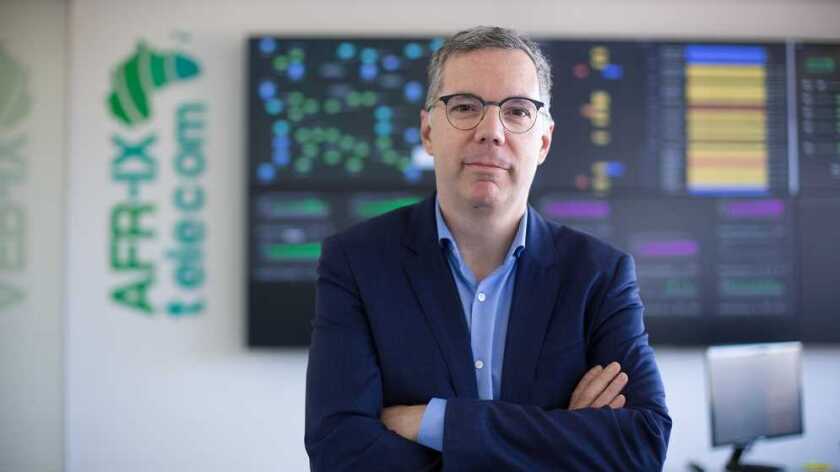Boasting 24-fibre pairs and an overall capacity of roughly 480Tbps (20Tbs per fibre pair), the cable will Lisbon and Sines, Portugal to Port Said, Egypt with additional landings in Barcelona, Torreguadiaro, Zahara and Alacant in Spain; Tétouan and Nador in Morocco; Algiers, Bizerte in Tunisia, Algiers and Collo in Algeria; Marseille in France; Mazara del Vallo in Italy; Yeroskipou in Cyprus; and Tympaki in Greece.
Valued at roughly €326 million, the project is currently under review to be partially financed by the European Investment Bank for a contribution of €163 million. Touted as largely a carriers cable, the presence of hyperscalers can't be ruled out, even a growing number of data centres.
By February AFR-IX confirmed that is has selected Alcatel Submarine Networks (ASN) as the vendor supplier.
Speaking exclusively to Capacity, Norman Albi, CEO of AFR-IX confirmed the announcement saying: "We carried out an Request for Quote (RfQ) in February of last year, for the four global providers, NEC, Huawei Marine Networks (HMN), SubCom and ASN."
"We received a response from three of them and then by summertime we had entered into the best and final offer process. Following which we went through an extensive selection process that was based on both technical and commercial considerations."
This in turn resulted both companies entering into exclusive negotiations at the end of 2021, with the contract being signed, awarding ASN the contract to supply and install the system.

The cable is to be built in two segments, the West Med branch (Portugal, Spain, France Italy and Greece) and the East Med branch (Tunisia, Greece and Egypt). Speaking on the landing arrangements of the cable, Albi explained:
"On the European Union side (the West Med brand), Medusa is the landing party. We may collaborate with some landing parties in a few locations so that we can use the existing infrastructure, but Medusa is the landing party for this branch."
He says that the company has already incorporated Medusa Portugal, Medusa Spain, Medusa France and says that Medusa Italy is "almost incorporated" adding that they are also in the process of incorporating Medusa Greece.
One of the biggest USPs of the system is its open access cable configuration, meaning that not only can anyone acquire capacity on the cable but it "can be connected to any type of technology or brand” and will offer a suite of services including full and half fibre pairs.
Speaking to Albi, however, he notes that these open access rules "do not apply in Northern Africa because we have to follow each one of the country's regulations which are not open access".
Using Egypt as an example, the rules are that you land with only operator as per regulations forcing the project to plan ahead. But he ensures us that all of the required permitting is in hand and has been even before securing its supplier.
This open model aside, Albi shares that the Medusa system will provide is direct fibre not providing capacity or using the traditional capacity model.
"What we're gving our customers is the possibility to acquire a fibre pair or an IRU (indefeasible rights of use) on a fibre between Lisbon and Marseille, or Barcelona and Sicily or in the case of North African operators they can buy their own fibre pair or IRU to any of the European destinations. Then they can activate and illuminate that fibre pair as they want."
This according to Alibi means that customers aren’t under the rules of the consortiums where they'd have to agree to a certain rate or any other conditions. Now, they can operate their fibre pair in any way they want.
AFR-IX will offer customers certain services on top of their acquired fibre on the off chance that they aren’t able to operate said services in certain regions or should they wish to outsource this to an independent company.
Part of this approach he says is driven by the fact that data demands are increasing at such a rate that mere capacity is not enough for most operators these days.
"If you look at Northern Africa, according to the data from Telegeography, in 2020 data traffic in Africa reached 24Tb. Of this 24 terabytes 45% is generated in North African countries and 55% is generated in Sub Saharan Africa. As we know there are about four or five countries in Northern Africa and they generate 45% of the total bandwidth of the continent – just demonstrating the rate of these bandwidth trends."
Making a few cursory calculations based on these figures. Albi says that puts each individual North African country as consuming roughly 4 or 5Tbs of traffic, on top of growth of approximately 40-50% year on year as has been the case for the continent, "you're going to see that these operators don't need capacity, they need fibre pairs because they will reach the top capacity of 20Tbs in three or four years".
Leveraging ASN's newly qualified 24 fibre pair cable design an achievement that Albi is very proud of.
"We even wanted more, but I think more than 24 fibre pairs will be a new generation of technology because it doesn't fit in amplifiers anymore."
He also points to the ever changing climate conditions in the Mediterranean as part of the reason that the company has partered with the Joint Task Force (JTF), which represents the combined efforts of three United Nations agencies (International Telecommunication Union, World Meteorological Organization, and UNESCO Intergovernmental Oceanographic Commission), in its work on SMART cables (Scientific Monitoring And Reliable Telecommunications).
"We're members of the JTF and we will work on integrating SMART functionalities into the system for amid climate change and oceanography issues," he said.
The project will also see the development of DAS (Distributed Acoustic Sensing) technology, which provides early warning of potentially damaging activities.
As the next steps for the project continue at pace, the system has a ready for service date of 2024 for the West Med branch shortly followed by the East Med branch in 2025.






